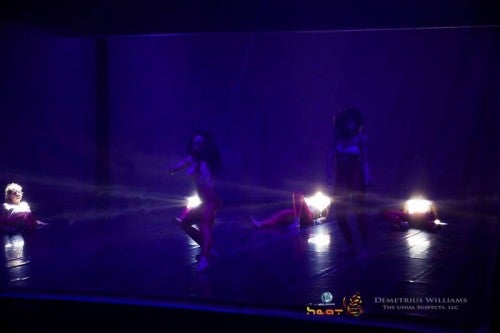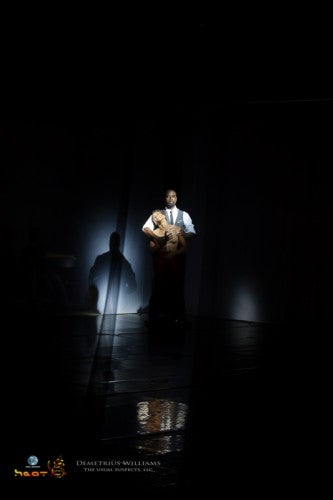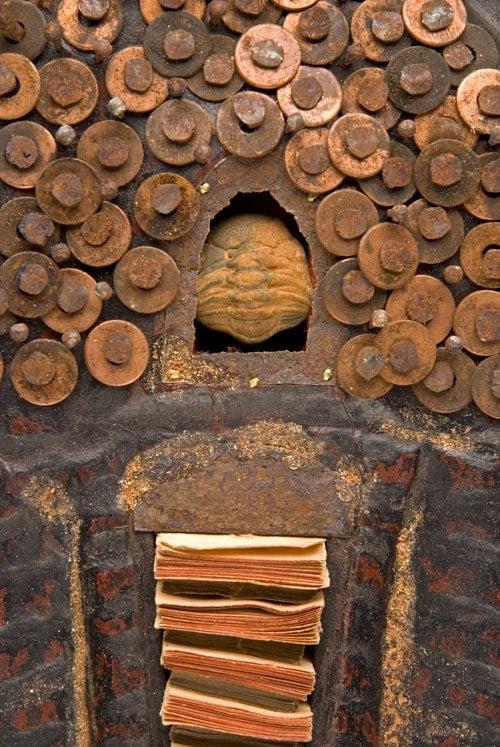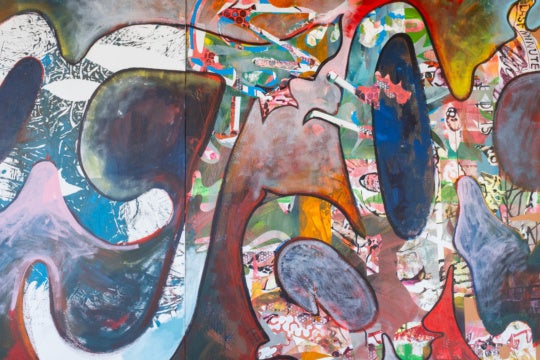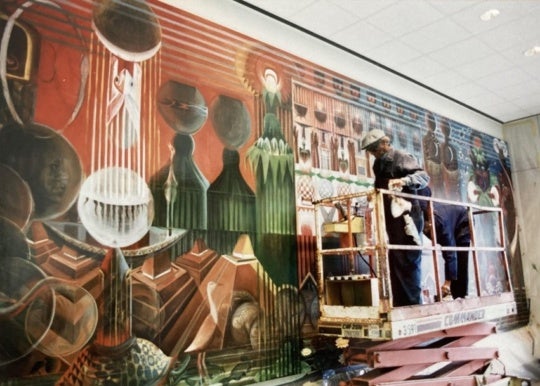
POST UP, T. Lang‘s recent performance at the Goat Farm Arts Center (June 6-8) provoked many more thoughts and questions than can be addressed in the span of a review, so here is an attempt to offer it something.
I got there early and took a seat. The audience surrounded the dance floor, separated by a scrim on each side. Looking through this cube, I could see audience members, silhouetted and hazy. They receded from my view. We were separated by a layer of obscurity.
A dancer entered this gauzy box. Video projections started, each sheet a screen—images of the cosmos. She breathed alone in this universe, trembling. She grabbed her belly, a gesture that carried throughout. She reached out an arm, cupped hand, brought it to her face. Did she swallow what she retrieved, incorporating it into her own body? It felt like our world had just been birthed.
POST UP is a dynamic and compelling work of power, loss, and recuperation. Working with composer John Osburn and video engineer Deigratia Daniels, Lang created an environment that held the dancers in suspension—between life and death, markers of time and space. The video imagery transitioned from outer space to (maybe?) fireflies, rain falling, a hypnotic diagonal pattern, vertical bars, with expanses of color interspersed between.
Reminiscent of James Turrell’s Ganzfeld works, these color fields provided the most visually potent domain for the movement; disorientation dominated. I have always wanted to see movement in Turrell’s almost-sterile environments. Lang’s desire to “make technology warm” affirms this sentiment. During the spans of abstract color, the complexity of the work shone forth. Held in this territory, the dancers seemed stuck in place. Though groupings of dancers constantly changed as they entered and left the floor, they always returned to this place that held them within its purgatory throes.
POST UP activates a layered dance history combining echoes of modern dance classics with contemporary popular dance. With external rotation, the dancers reached towards each other, to those on the other side of the screen, to no one. This bodily orientation, as well as other movement phrases—pairs that held each other, parted, and sprung back; the bare room; the elongated arms—brought to mind multiple elements of Pina Bausch’s Cafe Müller.
Indya Childs, the main dancer, with her aggressive and muscle-contracted movements, reminded me of another Bausch work, Frühlingsopfer. The elements of earth and color that are prominent in Frühlingsopfer (the red cloth, the red dirt that covers the dance floor) are echoed in POST UP’s costuming: red leggings and beige/gold bra tops. The red references Georgia clay, the ground to which our bodies return and that Lang’s dancers scratch at.
During a segment when the Hudson Mohawk track “Bugg’n” played, some of Lang’s movements suggested choreography from Kyle Abraham / Abraham.In.Motion’s dance piece The Radio Show. The chest heaving and deep backbends that reached for both the ground and for something to hold onto elicited extremely raw emotion and evoked such popular dance moves as Beyoncé’s chest popping and the Bernie dance, an Internet meme that originated in the U.S. South in 2009-10, and has gained some divisive attention.
Some of the dancers’ movements seemed to emerge from their heart space, an impression that was underscored towards the end, when light burst forth from their chests (actually overhead lighting, but the illusion was effective).
This outpouring is both hopeful and devastating. Lang resolves the tormented searching at the end by introducing a father figure, who embraces Childs in his arms. I’m torn about this ending. I might have preferred it if she had left me with nothing—no resolution, no hope. However, my preference for torment may be a result of privilege; I can choose to remain unresolved. This is more tricky with POST UP. The work addresses both personal and historical loss (that of Lang’s father and of slaves forcefully separated), and I struggle to say whether we should have been cast out into the darkness bereft of hope or held in the father’s arms bathed in reassuring white light.
Meredith Kooi is the editor of Radius, an experimental radio broadcast platform based in Chicago. She is currently a PhD student in the Graduate Institute of the Liberal Arts at Emory University, a performance and visual artist, and a monthly contributor to Bad At Sports.


